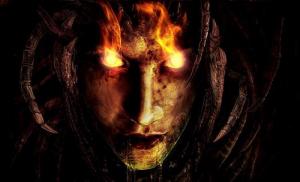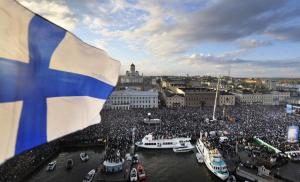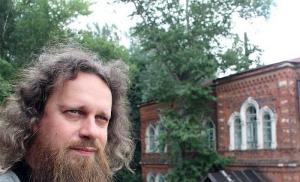Rebbe Leo. Riddle six - Prague golem
Yehuda Liva (Lev) ben Bezalel (also called the Maharal of Prague) (1512-1609) was a famous rabbi and expert on the Jewish Law, thinker and scientist. He also studied secular sciences, and was especially advanced in mathematics. According to legend, it was he who created the first artificial man -.
Ten facts about the Maharal from Prague
1. Yehuda was born in 1512 in the city of Poznań, into a family of illustrious rabbis. His uncle Jacob was the chief rabbi of the Holy Roman Empire. According to family tradition, R. Yehuda was a descendant of King David himself.
Bezalel, Yehuda's father, gave his children a good Jewish education. Therefore, all his sons became famous rabbis.
2. In those days, it was customary for European Jews to call children by two names: Hebrew and the corresponding Yiddish or German. For example, many Jews were called Dov-Ber - i.e. "bear" in Hebrew and Yiddish, or Zvi-Hirsh, "deer". Yehuda also received the middle name Lev, from the German Löwe (Lev) - since the Lion was a symbol of the tribe of Yehuda, from which, according to legend, the Bezalel family comes.
3. Growing up, r. Yehuda thought about marriage. His bride was a girl named Perla, the daughter of a wealthy merchant, Shmuel Reich. Shortly before the wedding, he suddenly went bankrupt and could not pay the promised dowry. This was a legitimate reason for breaking off the engagement. However, r. Yehuda agreed to wait until Shmuel corrected his affairs. And indeed, soon the fortune changed, and he became rich again. After that r. Lev married Pearl.
4. When the chief rabbi of Prague died in 1584, Maharal became one of the candidates for this position. However, at the last moment, another person was chosen. Perhaps this was due to the fact that the Maharal often denounced the city's wealthy, who oppressed the poor, paid little wage workers and distributed the burden of taxes unevenly.

5. Only in 1588 p. Yehuda was invited to lead the community in Prague. In those days, this city was one of the intellectual and cultural centers of Europe. Here was the residence of the Holy Roman Emperor Rudolph II, a famous patron of sciences and arts. The emperor was struck by the wisdom of the Prague rabbi and subsequently often talked with him. In addition, r. Yehuda became friends with many of the scholars who lived at the court. He became especially close to the famous astronomer Tycho Brahe.
6. Even during his lifetime with the name r. Yehuda was associated with many legends. According to one of them, one day during the parade, the horse on which Emperor Rudolf rode suddenly went berserk. Everyone was terrified, but suddenly a rabbi came out of the crowd and with one word calmed the raging animal.
7. The most famous legend associated with the name of r. Leva, is a story about a golem, a clay man, whose r. Yehuda blinded and revived by putting a note in his mouth with the unpronounceable name of the Almighty. So the rabbi created for himself a servant who helped him during the week. Every Friday, Bezalel took out a note, and the golem “died” for the whole Saturday. Once r. Leo forgot to do this, and the golem, which grew unusually in size, began to run around the city, threatening all living things. R. Yehuda caught up with the golem at the time of the onset of Saturday, tore out a magical note from his mouth, and the golem turned into a huge shapeless mass of clay, under which, according to one version of the legend, the famous sage died.
8. Rabbi Loew was a rabbi at the Old-New Synagogue. During the Second World War, almost the entire Jewish quarter of Prague was destroyed. But the synagogue survived. Among the Prague Jews who survived the Holocaust, there were legends that the golem himself saved his synagogue.

9. R. Yehuda is one of the few rabbis who have become heroes of fiction. Your parents, and you yourself, probably read the novel "Monday begins on Saturday", which mentions the medieval alchemist and magician Lev Ben Bezalel. As you may have guessed, this "wizard" - r. Yehuda. You must remember that there are golems in this story. And yet - the poem "Golem" Jorge Luis Borges considered his best work.
10. R. Yehuda died in Prague and was buried in the local Jewish cemetery. His grave has been preserved to this day. It is visited by numerous pilgrims and tourists. It is said that a righteous person saves from toothache and performs many other miracles. If you are in Prague, go to the Jewish Quarter. There, a wonderful monument was erected to Rabbi Lev, who glorified his city.
There are many Kabbalistic terms here that I have neither the strength nor the sense to explain (well, if I understand them myself ...), but the meaning is clear: the Rebbe is able to pull a Hasid out of any dirt, and save him from any danger. How he does it? The Rebbe has his own "secrets of the firm" ...
In 1947, two years after the end of World War II, Rebbe Chana Schneersohn, the mother of the Rebbe, arrived in Paris to continue her journey from there to the United States to be with her son. This was after many years in exile with her husband, Rabbi Levi Yitzhak Schneersohn, an exile from which he never returned.
The Rebbe, who was then only the son-in-law of the Rebbe Rayats, flew to Paris to meet his mother, whom he had not seen for many years, and accompany her on her way to the United States. The Rebbe was in Paris for several months to collect the necessary documents for entry into the United States, and during this time the Chabad Hasidim in Paris took the opportunity to ask the Rebbe to do something with them. itvaadut(Hasidic feast).
At one of the itwaaduts, several Hasidim asked the Rebbe to ask for them to awaken "great mercy" from his father-in-law, Rebbe Rayats, so that they could get visas, leave France, and come to the United States. The Rebbe looked at the Hasidim - among them were some very famous Hasidim - and smiled.
Do you think - said the Rebbe - that someone should remind the Rebbe to think about you, and awaken the mercy of Heaven on you? I'll tell you a story.
As a result of the arrest and torment that Rebbe Rayatz experienced in the dungeons of the GPU, Rebbe Rayatz fell ill. When he was already in the US, for some time a nurse came to him to give him an injection. It always happened at exactly the right time - 7 am by the clock.
The Rebbe sat at the table, ready for the procedure. The nurse came in, gave an injection, and left.
One day, the Rebbe tells, she arrived one minute early. She knocked on the door of Rebbe Rayats' room, but no one answered. She waited until 7 am, knocked again - and again no one answered. She opened the door and went in, and suddenly she sees that Rebbe Rayatz is sitting with his back to the door, his eyes are closed, and it seems that he is not here at all.
The nurse was terribly frightened, called family members, the wife of Rebbe Rayats, etc. - and everyone was also scared, and sent for the Rebbe (son-in-law) to come immediately. The Rebbe came, saw the state of his father-in-law, but was not at all frightened, he only bowed his head to his father-in-law's lips, and heard that he was saying very quietly "Song of the Sea." The Rebbe told the nurse and family that everything was fine and there was no need to worry, just wait. After a while, the Rebbe awoke from where he was and returned to his normal functioning.
That night, twelve hours later, a telegram arrived from Russia that a group of Hasidim were in mortal danger when they crossed the border, and if they were captured, they would all be in danger of death. The moment they were able, with the help of the Almighty, to cross the border - and they had the great help of Heaven in this - it was exactly the hour when the Rebbe was, as it were, "in prostration" and whispered "Song of the Sea."
So, the Rebbe concluded his story, know that the Rebbe is with every Hasid, especially with Hasidim close to him, and thinks about them constantly, especially when they are in danger. When one of the Hasidim is in danger - the Rebbe is next to him, awakens the Mercy of Heaven on him, as if taking him by the hand, and leads him out of a dangerous place.
Rebbe and Hasid
This story shows how closely the righteous man is connected with his Hasidim. Every Jew is capable, here and now, of becoming a Rebbe's Hasid. There is a super-conscious connection between the Rebbe and the Hasidim. Although there is also a thought here, it is said that the Rebbe thinks about his Hasidim (and not just prays for them), and besides the fact that he feels them and knows what is happening to them, there is something much higher here, the ability of the Rebbe by the power of his thoughts to get your Hasid out of any dirt, out of any danger. However, this "thought" of the Rebbe about his Hasid is not reason at all. It is clear that the Rebbe does this by awakening the mercy of Heaven so that they will not be captured and that they will succeed, higher than the nature of things.
Since we are told this story in such a way that there is no need to ask the Rebbe to awaken the mercy of heaven, since somehow the Rebbe is connected by his very essence with his Hasidim, we will explain here one more point from the point of view of Kabbalah and Hasidism.
"Awaken rahamim rabim"on someone - means to awaken the secret dikna, reach dikna-kadisha in Arich Anpin, 13 measures of mercy in keter- there is a source rahamim rabim. When you need to perform a miracle, higher than the nature of things, you need to attract rahamim rabim from keter and not enough ordinary mercy zeer anpin.
Attraction down, and exposure at the top
Why does the Rebbe laugh when the Hasidim ask him to mediate and awaken the "great mercy"? - It is clear that the Rebbe's intuition about his father-in-law - and if there is anyone who has an intuition about the previous Rebbe, it is undoubtedly the Rebbe himself - the place from which salvation came - is even higher than dikna a arih anpin, or even its source. Kabbalah says that 13 tikuney dikna have two sources (to understand it properly - you need to deeply study the writings of Arizal) - moha stimah, hidden meaning in keter which is called in Hasidut koah maskil, and even higher than that, keter above keter, goolgolta, "great love" or Hefetz, higher than just the will to create worlds.
Here, in this story as it is told, there is a connection keter between these two aspects: the Rebbe's thought of you comes from moha stimah. And the fact that he thinks of you with great love, does not just think, but loves you with infinite love, and this infinite love of the Rebbe for you is, in fact, the “right hand” that can reach you. "Right hand" - always khesed but there is a right hand in zeer anpin, about which it is said "and his right hand will embrace me", this is close to me. And there is a right hand-chesed in atik who dresses in goolgolta, hand hugging the whole world.
So you can imagine the Rebbe, as in this story: he leads you out of exile and from mortal danger, with his endless right hand, and at the same time he is completely focused on you, and even prostrated (as in this story), because he does not is here, but is with his Hasidim, his hand embraces them, and so he leads them out).
These two aspects are Chafetz Chesed(vest chesed deathik in gulgolta dearih) together with the ability to influence remotely, in hidden thought, these are two sources 13 tikuney dikna from which great mercy is drawn into the world.
Rabbi Yosef Yitzhak Schneersohn, 6th Lubavitcher Rebbe
Great mercy. There are a lot of Kabbalistic terms here, and to explain them you need to write a whole treatise on Kabbalah. I'm not ready yet... (translator's note)
Did you like this material? |
Jews in the OUN-UPA part 2: Lev Rebet
Lev Rebet (pseudonym Kil; born March 3, 1912, Stry - October 12, 1957, Munich) - Ukrainian publicist and lawyer of Jewish origin, one of the leaders of the Organization of Ukrainian Nationalists OUN.
After graduating from the gymnasium, he graduated from the Faculty of Law of the Lviv University. Since 1928, a member of the Ukrainian Military Organization of the UVO. Since 1934, the head of the Organization of Ukrainian Nationalists OUN in the city of Stryi. In the period from 1935 to 1938 the regional leader of the OUN.
After the declaration of the restoration of the independence of the Ukrainian state in Lvov on June 30, 1941, he was deputy head of the Ukrainian government headed by Yaroslav Stetsko, and after his arrest by the German authorities - acting head of government. After his arrest in the autumn of 1941 and until December 1944, he was a prisoner of the Auschwitz concentration camp.
Since 1945 in Munich, head of the organizations of the OUNR. 1945-1948 - chief judge of the OUN abroad. Z 1948 - Together with Mykola Lebed, Ivan Butkovsky and Miroslav Prokop, he becomes one of the leaders of the OUNR, and later - its chairman.
Scientific activity
1949 - defended his doctoral dissertation on the topic "State and Nation". Since 1952 - Associate Professor, and since 1954 - Professor of State Law at the Ukrainian Free University in Munich. Since 1955 - editor-in-chief of the socio-political magazine "Ukrainian independent". Author of numerous works on the theory and history of the Ukrainian nation, in particular, "Theory of the Nation", "State and Nation", "Formation of the Ukrainian Nation", "Light and Shadows of the OUN", "The Origin of Ukrainians, Russians and Belarusians in the Light of Modern Soviet Theories" .
Murder
Like S. Bandera (10/15/1959), Lev Rebet was killed on 10/12/1957 by KGB agent B. Stashinsky. Nikita Khrushchev followed the progress of the operation. The Ukrainian émigré press reported the death of Lev Rebet "from a heart attack", but later it became known that he was killed with a special poison.
He was buried at the Waldfriedhof cemetery (German: Waldfriedhof) in Munich.
On October 30, 2010, he was reburied in Lviv at the Lychakiv cemetery. To pay tribute to the outstanding political, public and scientific figure came the first persons of the city, headed by Mayor Andrey Sadov.
Role in History
Lev Rebet was the son of a postal official, born in 1912 in the city of Stryi in the Lviv region. From childhood, he was distinguished by deep religiosity and devotion to the Ukrainian national idea. He participated in the youthful movement of scouts, already at the age of 15, studying at the Ukrainian gymnasium Stryi, he became a member of the Ukrainian Military Organization (UVO), later a member of the OUN. Later, recalling those years, Rebet wrote, obviously referring to himself: “The main base of the OUN was young people, primarily students. These young people grew up in the tradition of Ukrainian statehood, they remembered the existence, albeit short-term, of an independent state, they saw the Ukrainian army with their own eyes, in a word, they had already experienced the position of the Ukrainian state for which they were going to fight. State independence was not an unrealizable fantasy for her; young people have already seen this independence, and it really stood before their imagination - it was only necessary to find it.
It was precisely this goal that Lev Rebet dedicated his life, a man who, like thousands of his peers - participants in the national movement, from childhood felt the "hunger of rank", wanted active actions, and not just beautiful, but abstract words about freedom. Almost from the moment of the establishment of the Organization of Ukrainian Nationalists (1929), the young Lev joins its ranks. It was precisely the belonging to the OUN that Rebet was accused by the Polish occupation authorities, and it was for this that he was arrested by it. Organizational ability and devotion to the common cause were duly appreciated by the leadership of Ukrainian nationalists: from 1934 to 1938 he was the conductor of the Regional Executive of the OUN in Western Ukraine. It is characteristic that after the split of the OUN (1940). Rebet supports Stepan Bandera, not Andrey Melnik.
When the restoration of an independent Ukrainian state was announced in Lviv on June 30, 1941, Lev Rebet was appointed Deputy Chairman of the Ukrainian State Board (headed by Yaroslav Stetsko), and after the arrest of the latter, he served as the Prime Minister of the board for some time. Then - the arrest of the Gestapo, which tracked him down, and imprisonment in Auschwitz until the autumn of 1944. In 1945-1948, Rebet was the chief judge of the Foreign Parts of the OUN (at that time he moved to Munich), since 1948, together with Nikolai Lebed, Ivan Butkovsky and Miroslav Prokop, he became one of the leaders of the Political Council of the OUN (foreign), and soon - her head. The last years of his life (from 1954 to 1957) Rebet was a professor at the Ukrainian Free University.
Now we will not talk about Rebet, a political figure (this, in particular, is his difficult relationship with Stepan Bandera - an independent big topic), but about his works on the theory and history of the Ukrainian nation, for example, such as Theory of the Nation (1955) , "Formation of the Ukrainian nation" (1951-1957), "Light and shadows of the OUN" (a book of historical and memoir plan, 1955-1956). Because the ideas set forth by Rebet even now, after 50 years, are almost in no way outdated and deserve the proper attention of our public. The task that the author set himself in all these works is both simple and incredibly complex: to find out what a nation is in general (as a phenomenon), and then - what is the Ukrainian nation, what is the historical process of its formation and development, what are its characteristics? perspectives.
Here is the key thesis for Rebet from the work “Theory of the Nation”: “The relationship between the external and internal types of national life is determined by the circulation between the being that generated the idea and the idea that creates the being. A person is born and lives in the system of these relations equally by natural compulsion (born in his environment) and by his own choice (forms his individuality in him and fulfills his ambitions). For the nation as a community exerts the most intense influence, and a person belongs to it with all his nature and all aspects of his life. And further, developing the idea: “For this reason, nations are stable forms of human life, and the historically established social and socio-psychological structure of each nation is directly related to the structure of the state, which reflects its character. For states exist fundamentally as nation-states, and state and nation are related to each other in the same way that form and content are connected.
The question that worried Rebet the publicist was: how, through what stages and thanks to what did the formation of the Ukrainian nation take place, what is the chronological framework of this process? Exploring the complex historical conflicts of the Khmelnytsky era, he comes to the conclusion (of course, not everyone shares this point of view) that “the Ukrainian people in the Khmelnytsky era had not yet taken shape as a modern nation. And Khmelnitsky himself - in the end, as a gentry, completely captivated by the gentry's worldview, and the Cossack elders, who also came mainly from old Cossack or gentry families - contrary to the "elements" tended to build a state on the principles of estates that he himself understood. So it is natural that privileges and the basis of the estate system were one of the main demands of the Cossacks in all anti-Polish uprisings. And this, Rebet concludes, is just an indisputable sign of the absence of a modern nation, this is evidence of an archaic approach to creating a state that has long exhausted itself.
How did the researcher see the future of an independent Ukrainian state (and Rebet never had any doubts that it would arise!)? First of all, as a democratic state; that is why he unequivocally rejected the slogan "Ukraine for Ukrainians" (by the way, representatives of Stepan Bandera spoke very critically about this). After all, Rebet believed, “the Ukrainian people, being in Eastern Europe a people with the oldest agricultural culture, has the data to be also the herald of the advanced ideas of mankind in those expanses. Ukraine can and should become a model of political culture for the entire environment, and instead of tyranny, which for centuries in the East was represented by the Russian - white and red - empire, show an example of a modern democratic state, where the freedom and dignity of a person is not an empty phrase.
Obviously, the Soviet "authorities" regarded such ideas as too dangerous in the future for the "Unbreakable Union". That is why the order was given to kill Rebet (the specific facts are probably still hidden in the archives). They destroyed only an outstanding politician and scientist (by the way, a doctor of law), but by no means his ideas. We are now witnessing a national democratic revival that would not have been possible without people like Lev Rebet.
-->
previous related………………………………… next related
previous on other topics…………… next on other topics
25 Prague. Jewish Quarter.
The Jewish Quarter is located within Strictly Gorod. Jews have lived in Prague since at least the 10th century. At first they lived on Malaya Strana, then they moved to the other side in the ghetto. A wall was erected around the ghetto to protect the Jews from the wrath of the crusader knights. There was a time when they were expelled from Prague, there was a time when a separate settlement was allowed on the rights of a separate city, as happened under Emperor Joseph II (1781). The Jewish city was called that - Jezefov. In the 20th century, Prague's Jews made up a significant segment of the German-speaking population. They had a difficult relationship with the Czechs, the latter considered them to be the conductors of the imperial policy of Austria-Hungary. (Thus, in Schweik, only the Germans and Jews show a patriotic position. “At the corner of Krakowska Street, a bursh in a Carporant hat was beaten, shouting to Schweik: “Heil! Nieder mit den Serben!” (Heil! Down with the Serbs!”)” and "Several Jews from Pisek shouted a greeting: "Heil! Nieder mit den Serben!" They were so smeared in the face that they then did not show up on the street for a whole week") In 1939 there were 118,000. But after the transformation of the Czech Republic into a protectorate of the Reich the extermination of the Jews began. In 1945, 30,000 of them remained, then they emigrated. Now only 3,000 Jews live in Prague. The territory of the former ghetto has been turned into an open-air museum. Interestingly, this is what Hitler also wanted. He also intended to make a museum of the “exterminated ethnic group” here. This area is quite small and densely packed with tourists. By the way, they sell cheap souvenirs there.
This is the entrance to the ghetto. The Jewish Town Hall and the High Synagogue are visible. Its current appearance corresponds to the 19th century.
(More precisely, they ran past and went to look at the rest of Prague. There is indeed a very high concentration of Jews near this place, and most of the visitors to the memorial, as it seemed to me, are Jews. However, for Jews, the entrance to the memorial Jewish cemetery is at a discount.
Just please don't ask how exactly proof of their Jewishness is required from those wishing to buy a reduced ticket. It is said - they ran past - and further, to look for still unseen sights. approx. ed.)
In the cemetery there is the grave of Rebbe Leo (Chief Rabbi of Prague Leo ben Bezelelem). Rebbe Leo was a Kabbalist, in 1580 he made a Golem out of clay to do housework and protect the ghetto from enemies. Golem came to life when a tablet with the name of God was placed in his mouth. At night the sign was taken out, but one day it was forgotten. During this night, Gollem grew from his 150cm to a large size and became uncontrollable. With great difficulty, the tablet was taken away from him, but he was no longer revived, although his body mysteriously disappeared. There is an image of him near the Charles Bridge, made by modern puppeteers.
Next to it is the Church of the Holy Spirit. Please note that there is a Tibetan flag in the attic.
The name of the palace is reminiscent of Emperor Rudolph, about whom there were many legends. Here, one of them. In the ghetto, children began to die for no reason, and their ghosts began to be seen in the cemetery. Rebbe Leo managed to call the spirit of one of the dead children, who said that the children die because of the love of Emperor Rudolph for the banker's wife, Esther. He appears to her at night in a dream, and she cheats on her husband. The death of children is a punishment for adultery, even if it happens not in reality, but in a dream. After everything was revealed, Esther died, the children stopped dying, and the ghosts disappeared.
To simplify loading, the material is laid out in small pieces. As usual, you can navigate back and forth using the navigation buttons on the topic.
Magical Prague, Prague of stars and mandrakes are epithets that we can meet in descriptions of the atmosphere of Prague in the second half of the 16th century. Then, more precisely in 1583, the patron of science and art, Emperor Rudolf II, moved from Vienna to the heart of the Czech Kingdom. His court soon attracted both real scientists and artists, and shar-latans. All of them, together with the local nobles and philistines, who felt the new spirit of the times, helped to create a peculiar flavor that exists in Prague today.
Anniversary of Magaral
Visitors to Prague roaming the streets of Prague are mostly not attracted by the remarkable discoveries made here by scientists such as Tycho Brahe and Johannes Kepler. They listen with great interest to stories about magical and mystical Prague. While there are more than enough such stories to offer them, the brightest star in the firmament of urban legend is the tale of the Golem. The myth ascribes its creation to the learned rabbi Yehuda ben Bezalel (circa 1525-1609).
The Jewish scientist, also known as Rabbi Lev or Magaral, is still the personification of medieval Prague, where reality was mixed with legend, science with mysticism. The Prague Jewish community and the entire Czech community honored the memory of this great Jewish thinker. In 2009, the 400th anniversary of his death was celebrated. During this long time, as a sign of respect, no one sat in the rabbi's chair on the right side of the Old New Synagogue.
The collections of the Prague Jewish Museum contain several first editions of the works of Rabbi Lev. It was these works that became one of the most significant exhibits of the exhibition dedicated to the memory of Magaral. Restoration work was carried out at the Old Prague Jewish Cemetery, and the tombstone of Rabbi Lev, as well as the tombstones of his ancestors, descendants and family members, were put in order. The late Renaissance tombstone of Rabbi Lev and his wife Pearl is the cemetery's most frequently visited monument. Constantly flooded with waves of wax from brought candles, with cracks filled with pieces of paper with mysterious messages from pilgrims from different countries, the tombstone is evidence that the legacy of the rabbi is alive.
For the public, the legacy of the rabbi - a thinker and scientist - is still somewhat closed by his alleged creation of the Golem. Let's take a short digression to the time period preceding the moment when the rabbi and his assistants, on a dark night, found a deposit of clay that no man had touched, molded the Golem and breathed life into it with the help of magical formulas. Many stories are shrouded in shadows. But among them, this one is still an exception. The memory of Lev, the outstanding Prague rabbi, still lives on. Yehuda Leva was driven by the desire to know God's truth. He took up the replacement of letters and complex variations, Until he found the word that was the Key ... Jorge Luis Borges "Golem" The idea of creating an artificial being is very old. Even before the description of the most famous act of creation in the book "Genesis", the ancient Greek narratives left us the story of the titan Prometheus, who created the first people from clay and water, on whom the gods sent suffering and misfortune in the form of the next artificial creation: Pandora. The earthly creator was the legendary Pygmalion, who created a statue of supernatural beauty. But he managed to revive his work only with the help of the gods.
The medieval creators of artificial creatures were convinced that they would be able to breathe life into their homunculi. At the time when the Golem rose from clay in Prague, the most famous representative of alchemy, Paracelsus, proposed in his work “De generatione rerum naturalium” another, “biochemical” concept of creating an artificial being. The famous alchemist and physician advised putting the male seed in a hermetically sealed glass vessel, which was to be placed in horse dung for forty days. During this time, decomposition should have occurred in the vessel and a transparent human form without a body should have appeared. This form was to be nourished with a human blood remedy for forty weeks at a temperature corresponding to that of the mother's womb. Thus, "a human child, as if emerging from the womb of the mother, but only a little smaller" was to be born.
The method of the legendary rabbi proceeded from other principles, from a combination of divine creation and knowledge, where the alchemical theory of the four elements, the foundation stones of the world, had its place. “Four elements are needed to create a Golem or a homunculus. Namely, earth, water, fire and air,” the rabbi explained to his assistants before creating the Golem.
From the first element, the Golem was created, and the next three - water, air and fire - were the creator himself, along with his two students. The very same revival of the Golem took place with the help of the pronunciation of magical formulas, and according to another version, due to the insertion of parchment with formulas (shema) into the mouth of the Golem or into his forehead. The concept of "shem", with the help of which it was possible to revive the Golem, comes from Kabbalah, according to which one can repeat the Divine creative act with the help of the correct combination of letters of the Name of God. At the end of the process, the revived Golem was to be dressed and looked to be thirty years old.
Defender of the Jews
The reasons that led to attempts to create an artificial creature were different. Pygmalion asked to revive his work under the influence of love, Pandora was sent into the world as an instrument of revenge of the gods, Paracelsus proceeded from scientific considerations. One of the variants of the Golem myth has its own socio-political overtones. After the Golem first rose from the ground, the rabbi allegedly addressed him with the following words: “Know, heap of clay, that we created you from the dust of the earth, so that you protect the people of Israel from their enemies and protect them from all misfortunes and oppression, which our people are experiencing.
Rabin began to create the Golem after he heard a mysterious voice at night calling him to create a creature to protect the oppressed Jewish people. During the time of Rudolf II, the Jews in Prague lived well, however, legends tell us about conspiracies against them, which only the Golem managed to prevent. In a legend that arose when waves of anti-Semitism rose during the reign of the heirs of Emperor Rudolf II, there is a call for the arrival of a powerful protector who will protect the Jews from a hostile environment.
dangerous force
The golem was neither good nor evil, because it was not a man, but an artificially created being, freed from human feelings. The enormous power that was in him, he used, serving his master and his people. The golem did not know fatigue, and, moreover, it constantly accumulated energy. Therefore, on Fridays, the rabbi took out the shem so that the Golem would cool down. Despite the services that the Golem rendered to the rabbi, the latter came to the conclusion that the unusual servant should be disposed of. In the most traditional version of the legend, this happened after the rabbi went to the synagogue on Friday and forgot to take the Golem Shem out of his mouth. The energy accumulated in the Golem turned him into a raging monster, which was only able to be stopped by the rabbi himself, who interrupted the service in the synagogue. Taking out the shem, he turned the Golem into an immobile body, which, together with his assistants, then hid in the attic of the Old New Synagogue (later, there were more than enough of those who tried to find the Golem, among them was the "frantic reporter" Egon Erwin Kisch). In this layer of the legend, we encounter the interesting motif of the Golem as a not fully controlled creation of human thought and ability. At a time when other human discoveries and inventions are capable of destroying not only humanity itself, but also the planet on which it lives, a reminder of this is more than modern. The golem was supposed to evoke reflections on the limits of human knowledge, more precisely, on the rules that should be observed on the path in search of the truth. But even a learned rabbi would hardly have answered the question of what a shem should look like, which would protect us from modern threats.
Source of inspiration
Today we know that the theme of the Golem was present in Jewish literature long before the time of Rabbi Leo. We also know that the authorship was awarded to him later in the legend, we also know that the Prague Jews were saved from pogroms by an enlightened emperor, and not an artificially created protector. Despite this, the legendary Golem went to the world of literature, fine arts and cinema. The Golem theme asks inspiring questions that take the Golem from the realm of legend and art to the realm of natural science and philosophy.
Therefore, in the future, other Golems will certainly be added to the most famous literary Golems of Judita Rozenbergova, Gustav Meyrink, Jorge Borges and their film images created by Paul Wegener and Martin Fritsch. By the way, the international association "Golem" performs klezmer, diluted with punk rock. Peter Wagner













